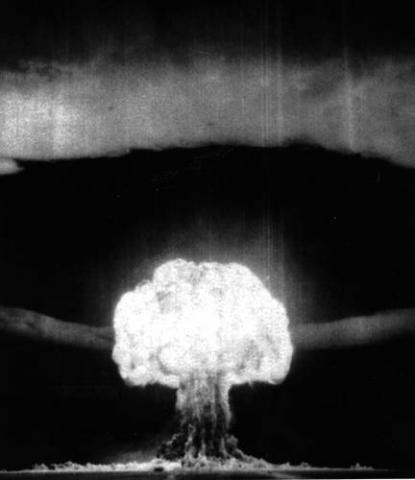The successful test of RDS-1 in August of 1949 inspired the Soviet government to institute a major, high-priority program to develop the hydrogen bomb. The Soviets, who received information from Klaus Fuchs regarding the American hydrogen bomb program throughout the late 1940s, knew that thermonuclear weapons were theoretically possible. They also knew that the hydrogen bomb would have to be developed in order to counter the perceived “American threat” abroad.
The effort to develop a thermonuclear weapon was led by Soviet physicist Andrei Sakharov, widely considered the “Father of the Soviet H-Bomb.” Sakharov was the author of several key ideas that contributed to the Soviets’ thermonuclear design and his research played a key role in the development process.
RDS-6s (Joe-4)
A little less than a year after the United States tested its first thermonuclear device with the Mike Shot on November 1, 1952, the Soviets tested their own thermonuclear bomb. On August 8, 1953, Soviet Premier Georgy Malenkov announced that the United States no longer had a monopoly on the hydrogen bomb. Four days later, on August 12, 1953, the RDS-6s test, the first test of a Soviet thermonuclear device, took place.
The test, which became known as Joe-4 (this had been the fourth Soviet nuclear explosion whose occurrence was announced by the United States), took place at the Semipalatinsk test site and yielded roughly 400 kilotons of TNT. The explosion took place on a tower; the purpose of this was to reduce the fallout hazard which would be created as a result of the explosion. The test vaporized the steel tower and left a massive crater in its place. The area surrounding the crater was covered in a “yellow lumpy glass” which became thinner from the epicenter.
A U.S. panel, led by Hans Bethe, assessed radioactive material gathered after the test and argued that it did not constitute a “true” hydrogen bomb, concluding that the fusion reactions in the device were responsible for no more than 20% of its power. Though Joe-4 produced a significantly smaller yield than the Mike Shot or Bravo Test in the American thermonuclear test series, the Soviets argued that this weapon was ready for immediate use and could be delivered by a bomber. On November 22, 1955, the Soviets detonated their first megaton-range hydrogen bomb, RDS-37. As historian Alex Wellerstein notes, Sakharov identified that test in his memoirs as a turning point in his journey from nuclear weapons designer to prominent dissident.
The Soviet Nuclear Program During the Cold War
The Soviet nuclear program that developed the atomic and hydrogen bomb during the early 1950s would continue to expand and accelerate during the Cold War. The U.S.S.R. sought to develop bigger, more powerful bombs to make up for what they perceived to be a disadvantage in the accuracy and reliability of their nuclear delivery systems. This would become one of the major reasons the Soviets developed and tested the massive super-bomb Tsar Bomba in 1961, which had a yield of 50 megatons of TNT. In contrast, the United States focused its efforts on producing smaller, more effective nuclear weapons that could be deployed on its medium-range ballistic missiles (MRBM) and inter-continental ballistic missiles (ICBM).





